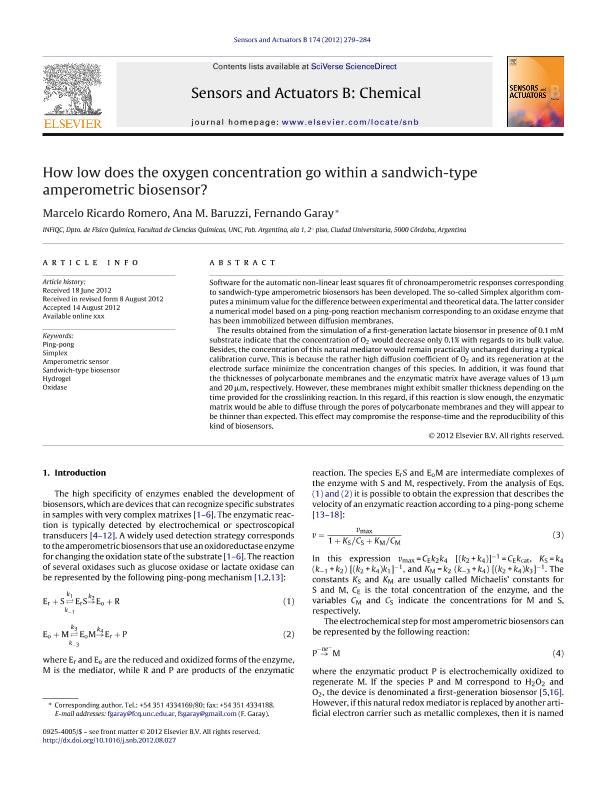Mostrar el registro sencillo del ítem
dc.contributor.author
Romero, Marcelo Ricardo

dc.contributor.author
Baruzzi, Ana Maria

dc.contributor.author
Garay, Fernando Sebastian

dc.date.available
2020-09-07T14:06:21Z
dc.date.issued
2012-11
dc.identifier.citation
Romero, Marcelo Ricardo; Baruzzi, Ana Maria; Garay, Fernando Sebastian; How low does the oxygen concentration go within a sandwich-type amperometric biosensor?; Elsevier Science Sa; Sensors and Actuators B: Chemical; 174; 11-2012; 279-284
dc.identifier.issn
0925-4005
dc.identifier.uri
http://hdl.handle.net/11336/113315
dc.description.abstract
Software for the automatic non-linear least squares fit of chronoamperometric responses corresponding to sandwich-type amperometric biosensors has been developed. The so-called Simplex algorithm computes a minimum value for the difference between experimental and theoretical data. The latter consider a numerical model based on a ping-pong reaction mechanism corresponding to an oxidase enzyme that has been immobilized between diffusion membranes. The results obtained from the simulation of a first-generation lactate biosensor in presence of 0.1 mM substrate indicate that the concentration of O 2 would decrease only 0.1% with regards to its bulk value. Besides, the concentration of this natural mediator would remain practically unchanged during a typical calibration curve. This is because the rather high diffusion coefficient of O 2 and its regeneration at the electrode surface minimize the concentration changes of this species. In addition, it was found that the thicknesses of polycarbonate membranes and the enzymatic matrix have average values of 13 μm and 20 μm, respectively. However, these membranes might exhibit smaller thickness depending on the time provided for the crosslinking reaction. In this regard, if this reaction is slow enough, the enzymatic matrix would be able to diffuse through the pores of polycarbonate membranes and they will appear to be thinner than expected. This effect may compromise the response-time and the reproducibility of this kind of biosensors.
dc.format
application/pdf
dc.language.iso
eng
dc.publisher
Elsevier Science Sa

dc.rights
info:eu-repo/semantics/openAccess
dc.rights.uri
https://creativecommons.org/licenses/by-nc-sa/2.5/ar/
dc.subject
AMPEROMETRIC SENSOR
dc.subject
HYDROGEL
dc.subject
OXIDASE
dc.subject
PING-PONG
dc.subject
SANDWICH-TYPE BIOSENSOR
dc.subject
SIMPLEX
dc.subject.classification
Físico-Química, Ciencia de los Polímeros, Electroquímica

dc.subject.classification
Ciencias Químicas

dc.subject.classification
CIENCIAS NATURALES Y EXACTAS

dc.title
How low does the oxygen concentration go within a sandwich-type amperometric biosensor?
dc.type
info:eu-repo/semantics/article
dc.type
info:ar-repo/semantics/artículo
dc.type
info:eu-repo/semantics/publishedVersion
dc.date.updated
2020-09-02T19:04:52Z
dc.journal.volume
174
dc.journal.pagination
279-284
dc.journal.pais
Países Bajos

dc.journal.ciudad
Amsterdam
dc.description.fil
Fil: Romero, Marcelo Ricardo. Consejo Nacional de Investigaciones Científicas y Técnicas. Centro Científico Tecnológico Conicet - Córdoba. Instituto Multidisciplinario de Biología Vegetal. Universidad Nacional de Córdoba. Facultad de Ciencias Exactas Físicas y Naturales. Instituto Multidisciplinario de Biología Vegetal; Argentina
dc.description.fil
Fil: Baruzzi, Ana Maria. Consejo Nacional de Investigaciones Científicas y Técnicas. Centro Científico Tecnológico Conicet - Córdoba. Instituto de Investigaciones en Físico-química de Córdoba. Universidad Nacional de Córdoba. Facultad de Ciencias Químicas. Instituto de Investigaciones en Físico-química de Córdoba; Argentina
dc.description.fil
Fil: Garay, Fernando Sebastian. Consejo Nacional de Investigaciones Científicas y Técnicas. Centro Científico Tecnológico Conicet - Córdoba. Instituto de Investigaciones en Físico-química de Córdoba. Universidad Nacional de Córdoba. Facultad de Ciencias Químicas. Instituto de Investigaciones en Físico-química de Córdoba; Argentina
dc.journal.title
Sensors and Actuators B: Chemical

dc.relation.alternativeid
info:eu-repo/semantics/altIdentifier/url/http://www.sciencedirect.com/science/article/pii/S0925400512008416#
dc.relation.alternativeid
info:eu-repo/semantics/altIdentifier/doi/https://doi.org/10.1016/j.snb.2012.08.027
Archivos asociados
